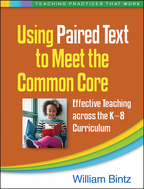Using Paired Text to Meet the Common Core
Effective Teaching across the K-8 Curriculum
William Bintz
This title is part of the Teaching Practices That Work Series, edited by Diane Lapp and Douglas Fisher.
“This book is a treasure trove for teachers implementing the Common Core State Standards. Bintz effectively demonstrates the use of children’s literature as a centerpiece for Common Core-focused instruction. The sample lessons and examples of paired text are wonderful resources for busy teachers who value and honor the important place of children’s literature in their classrooms.”
—Barbara Moss, PhD, School of Teacher Education, San Diego State University
“Using paired text is a sound pedagogical practice that has the potential to help students increase reading engagement, expand their knowledge base, enrich conceptual understanding, and develop critical insights about language and text—all of which are consistent with the goals of the CCSS for English language arts and disciplinary literacy. This book is chock-full of trade book resources, instructional strategies, and convenient reproducibles that all K-8 teachers will find relevant and useful.”
—Zhihui Fang, PhD, School of Teaching and Learning, University of Florida
“As someone who is devoted to providing readers with strategies to attack, survive, and enjoy texts, I found Bintz’s book rewarding. His experiences and connections mirror what K-8 students do as they learn how to gain confidence while reading. Bintz’s rationale for using paired text in English language arts, social studies, science, and mathematics is practical, and he proves how this addresses the CCSS by outlining the anchor standards. This book should be on the reading list of K–8 classroom teachers, reading specialists, and instructional coaches.”
—Marie Donnantuono, MEd, College of Education, William Paterson University
“When carefully paired, books can be used together to initiate much-needed conversations in ELA, history, science, and mathematics, while supporting students in exploring what makes each discipline unique. This extremely practical book shows how to do just that. It features easy-to-follow strategy lessons and reproducible materials that can be photocopied or printed out for immediate use. It is a ‘must have’ resource for teachers across grades and disciplines. Schools would be well served by buying a copy for every teacher in their building.”
—Jerome C. Harste, PhD, Distinguished Professor Emeritus, Department of Literacy, Culture, and Language Education, Indiana University
Table of Contents
IntroductionI. Intertextuality
What Is Intertextuality?
Understanding Intertextuality
Intertextuality and Picture Books for Young Children
Intertextuality and Picture Books for Older Children
Intertextuality and Picture Books for Adolescent Readers
Intertextuality and Picture Books across the Curriculum
Intertextuality and the CCSS
Intertextuality, the Common Core, and Paired Text
II. Paired Text
What Is Paired Text?
Mini-Lesson: Seeing and Thinking Differently
Purpose of Paired Text
Paired Text and the CCSS
Types of Paired Text
Benefits of Paired Text
Paired Text and Picture Books
Picture Books and Paired Text across the Curriculum
Finding Picture Books for Paired Text across the Curriculum
Using Paired Text
III. Paired Text in English Language Arts
Mini-Lesson: Perspective and Point of View
Intertextual Connections
Paired Text, Intertextual Connections, and the CCR Anchor Standards
Additional Paired Text on Perspective and Point of View
Theoretical Model
Paired Text for ELA Standards by Grade Levels and Grade Bands
Additional Instructional Strategies
IV. Paired Text in History/Social Studies
Mini-Lesson: Drummer Boys in the Civil War
Intertextual Connections
Theoretical Model
The CCSS, the NCSS, and Paired Text
Additional Instructional Strategies
V. Paired Text in Science
Mini-Lesson: How Do Scientists Do Science?
The CCSS Reading Standards for Literacy in Science
The Next Generation Science Standards
Theoretical Model
Paired Text and the CCSS and NGSS Standards
Additional Instructional Strategies
VI. Paired Text in Mathematics
Mini-Lesson: Multiple Ways to Solve Single Problems
Intertextual Connections
More Potentials
The CCSS for Mathematics
Theoretical Model
Paired Text and Mathematical Content
Additional Instructional Strategies
Appendices
References
Picture Books Cited
Index
